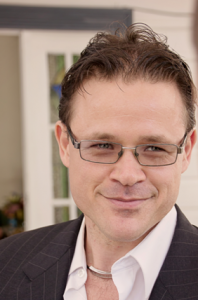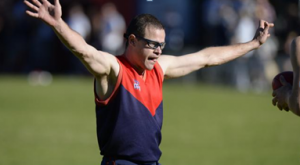Barnaby, 34,Ex-professional AFL player who experienced a stroke after being beaten unconscious in an alcohol-fuelled gang attack, SYDNEY – September 15, 2015
 Nowadays, ex-professional AFL player, newlywed and motivational speaker, Barnaby, 34, Sydney, spends most of his time travelling the world with his beautiful wife, Angela, on a “seemingly endless honeymoon,” motivating people from all walks of life about the importance of “focusing on the game plan and letting the result take care of itself.”
Nowadays, ex-professional AFL player, newlywed and motivational speaker, Barnaby, 34, Sydney, spends most of his time travelling the world with his beautiful wife, Angela, on a “seemingly endless honeymoon,” motivating people from all walks of life about the importance of “focusing on the game plan and letting the result take care of itself.”
However, when captaining Sydney AFL team, Pennant Hills, in his mid-twenties, following a professional stint with the Sydney Swans, Barnaby experienced a stroke of bad luck. In June 2005, while enjoying a night out on the town on North Sydney with friends, Barnaby leapt to his friend’s defence, after watching him be king-hit by a drunken gang of 20, and Barnaby was also beaten unconscious in the aftermath.
Unaffected for a week after the alcohol-fuelled gang attack, Barnaby attended football training and even played a game. However, eight days later, during squad selection, Barnaby began “seeing double”. As a precaution, he was driven to his parents’ home, where he subsequently lapsed into a coma, from which his family was informed, he may not wake. Barnaby had suffered a stroke.
Four days later, Barnaby awoke from his coma in the intensive care unit of the Sanitarium Hospital.
Since then, it has taken Barnaby a decade to rebuild his life, during which he has graduated from the University of Technology, Sydney, climbed Mount Kilimanjaro, hiked the Kokoda Trail and played his 100th game of AFL.
This is Barnaby’s inspiring story.
“When I was bashed in an alcohol-fuelled gang attack, it caused trauma to my brain and tore my basilar artery,” said Barnaby.
“When my artery tore, a blood clot formed, and over the next week, it travelled up into my brain, causing a stroke.
“I was only 25 at the time, and it shocked everyone. Everyone thought I was too young to have a stroke. But the trauma from the fight is what led to my stroke,” Barnaby said.
Nearly a week after the fight, Barnaby was at Pennant Hills Football Club training for team selection, when he began to feel “a bit funny,” as his vision started to blur.
Living with insulin-dependent Type 1 diabetes, Barnaby mistakenly attributed his blurred vision to his existing health condition.
As a precautionary measure, Barnaby was driven to his parent’s home, where, upon arrival, he collapsed and blacked out at the front door.
Four days later, Barnaby awoke from a coma in the intensive care unit of the Sanitarium Hospital.
“I basically blacked out and fell into a coma,” said Barnaby.
“I don’t recall having the stroke.”
After his stroke, Barnaby experienced paralysis in the left side of his body.
“The whole left side of my body was affected by the stroke. It wiped all the signals from my brain to the left side of my body. I couldn’t stand up without falling over, and I had coordination and strength issues with my left hand. My fine motor skills were particularly affected.
“I was left-handed, so I couldn’t write anything, and my vision was affected as well, so I had to start wearing glasses,” Barnaby said.
Barnaby spent the next four months recovering in hospital, and the ensuing six months in out-patient therapy.
 “Around the 12 month mark, I began to see most improvement in my condition.
“Around the 12 month mark, I began to see most improvement in my condition.
“I went from being wheelchair-bound following the stroke, to walking, and soon after, driving a car,” said Barnaby.
“After the first year though, improvements came slower, and 10 years later, I’m still recovering.”
“Research is showing, and I also agree, that doing things over-and-over again does pay off, and you re-learn movements or other things you lost from the stroke. It’s just a long, slow grind,” Barnaby said.
“My eyesight isn’t too great since I had a stroke, and that poses many of its own challenges.
“After getting my driver’s license back, I experienced a few rear-end crashes, and I almost ran someone down once. After that, I went and handed my license in,” said Barnaby.
“Things like washing the dishes are a little tougher for me, as the strength is still returning in my left hand, so this takes me a lot longer.
“Probably my biggest frustration with recovery is the length of time it takes to see improvements,” Barnaby said.
“In the back of my mind, I see little improvements, but the length of time it takes to truly recover can be deflating.”
Throughout his recovery process, Barnaby has visited many different therapists, including physiotherapists, speech therapists, and neuropsychologists, among others. In a bid to mount the best recovery possible however, Barnaby finally turned to someone whom he could trust, to act as his case manager – his football physiotherapist, Greg Castle.
“Greg acted as the umbrella to my recovery, he kept abreast of all areas of my recovery and I trusted him implicitly. I still continue to see him occasionally to discuss my recovery progress,” said Barnaby.
Since experience a stroke, Barnaby has discovered a new lease on life, and values the small things in life.
“Having a stroke so young, has given me an appreciation for the small things in life.
“A few months ago, I bought a biscuit from Woolworths, and used my left hand to eat it,” Barnaby said.
“I felt amazing after that, just knowing that I had the strength in my left hand to hold the biscuit and eat it.
“I was married last year, and was able to return to football for Pennant Hills,” said Barnaby.
“Nowadays, every time something of significance happens, it’s an amazing experience, and something I can appreciate for what it is, and even more that I’m here to experience it, having successfully overcome so many obstacles.
“It makes all the effort you invest in recovering so worthwhile,” Barnaby said.
Although his stroke did not follow the common route, Barnaby is a strong advocate for making good lifestyle choices to help prevent stroke. He reinforces the importance of having a Stroke Risk Assessment, given stroke can strike anyone.
“Stroke can affect anyone, at any age. Everyone is responsible for their own health, and importantly, up to 80 per cent of strokes can be prevented.
“You should do whatever you can to protect yourself against stroke, and that includes having a Stroke Risk Assessment,” said Barnaby.
If you suspect you, a family member or friend is at-risk of stroke, visit your local Blooms The Chemist pharmacist for a Stroke Risk Assessment this month. Stroke Risk Assessments are being run throughout major metropolitan and regional areas of NSW, QLD and in Melbourne. To locate your local Blooms The Chemist, or for further information, head to: http://www.blooms.net.au/monitoring-management/.
